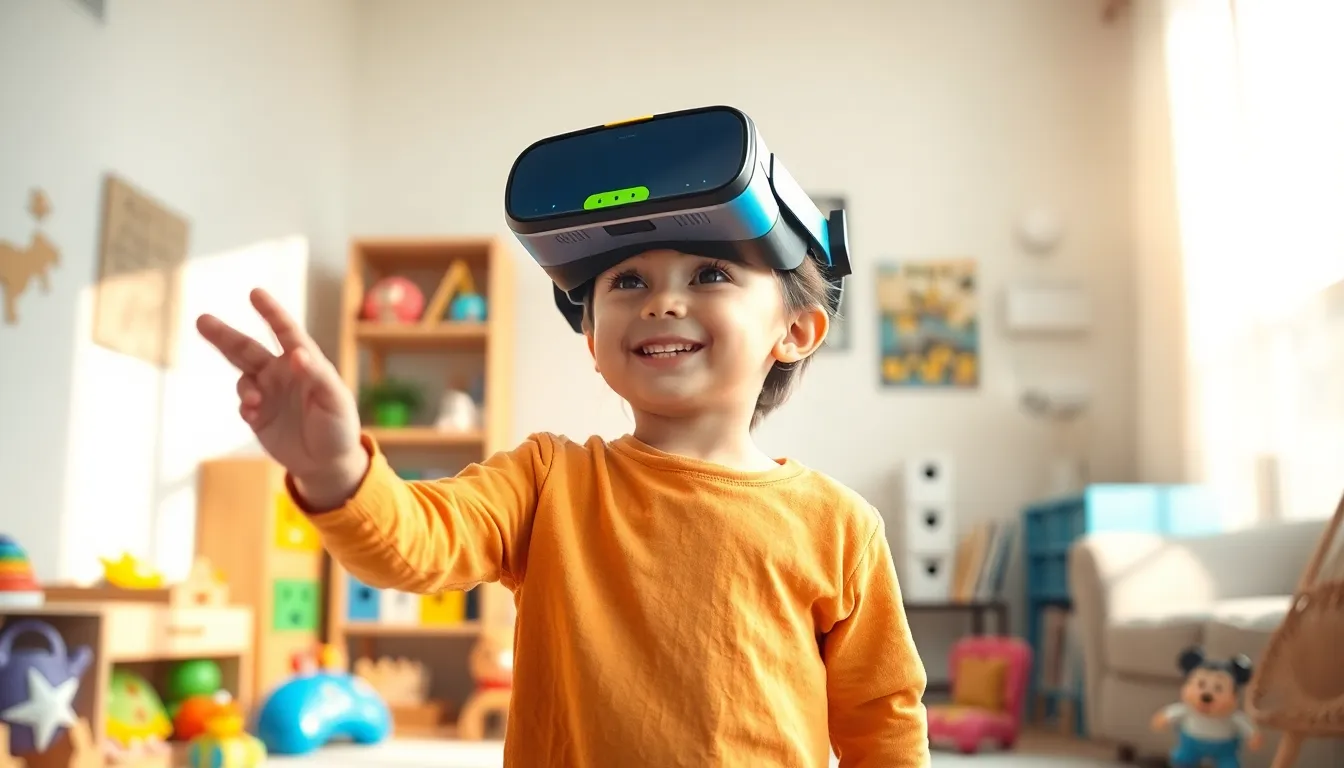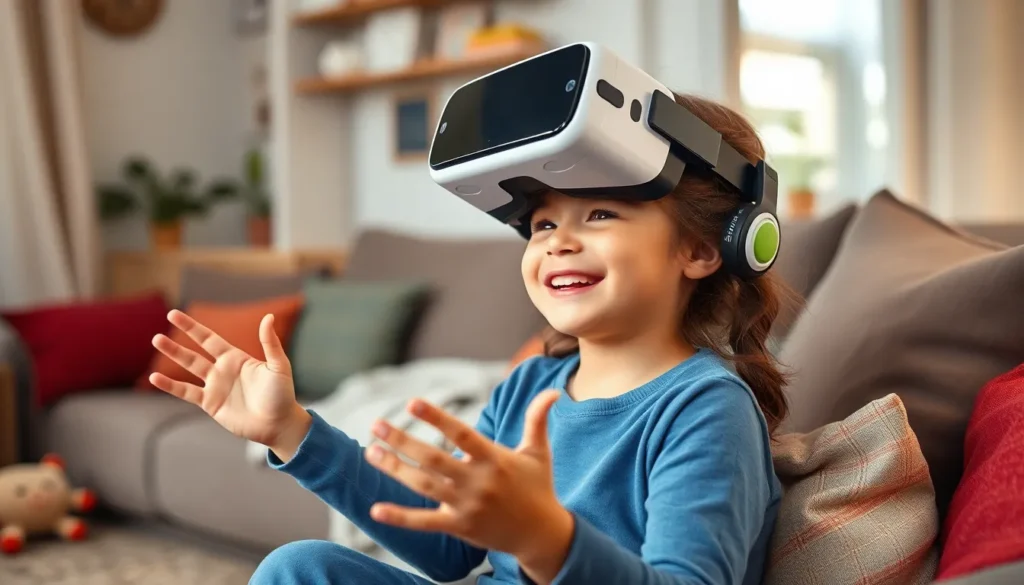Virtual reality is transforming the way kids experience entertainment and learning. With immersive environments and interactive gameplay, VR headsets offer a unique opportunity for children to explore new worlds from the comfort of their homes. As technology advances, parents are increasingly considering these devices for their kids, but they often wonder about the right choice.
Choosing the right VR headset for children involves understanding their needs, safety features, and age appropriateness. With a variety of options available, it’s essential to find a headset that balances fun and educational value while ensuring a safe experience. This guide will explore the best VR headsets for kids, helping parents make informed decisions in this exciting digital landscape.
Table of Contents
ToggleOverview of VR Headsets for Kids
VR headsets designed for kids offer unique and engaging experiences tailored to younger audiences. These devices combine immersive technology with interactive content to enhance play and education. When evaluating VR headsets for children, consider several essential features:
- Safety Features: Many headsets integrate parental controls, adjustable lenses, and adjustable head straps to ensure a comfortable and secure fit for kids.
- Age Appropriateness: The age rating of a VR headset often reflects the content and complexity of available games or experiences. Look for headsets that cater specifically to the developmental stage of the child.
- Content Selection: Popular VR headsets provide a variety of games and educational programs. Titles that promote learning, exploration, or creativity are available for children of all ages.
- User-Friendly Interface: An intuitive design facilitates easy navigation, allowing kids to focus on the content rather than technical complexities.
- Weight and Comfort: Lightweight headsets with soft padding enhance comfort, encouraging longer use without discomfort or fatigue.
- Durability: Kid-friendly headsets may incorporate reinforced materials or design elements to withstand rough handling, ensuring longevity.
Different brands and models are available, each varying in capabilities and price points. For example, headsets like the Oculus Quest 2 and the PlayStation VR provide high-quality experiences but might require adult assistance during setup. In contrast, devices like the Oculus Quest for Kids and the Merge VR are specifically designed for easier use by younger children.
When selecting a VR headset, prioritizing these factors helps parents choose the best option to foster safe and enriching experiences for their children.
Benefits of VR for Children

VR technology offers significant benefits for children, enhancing both learning and entertainment experiences. The immersive nature of VR allows kids to engage with content in dynamic and impactful ways.
Educational Purposes
VR serves as a powerful educational tool, immersing children in interactive learning environments. Virtual field trips transport kids to historical sites, outer space, or underwater ecosystems, enhancing comprehension. Subjects like science, history, and mathematics become tangible through simulations and visualizations. For instance, students can conduct virtual experiments or explore celestial bodies, reinforcing theoretical concepts. Research shows that VR can improve retention rates by up to 75% compared to traditional learning methods (source: Immersive Education Initiative). By engaging multiple senses, children develop critical thinking and problem-solving skills in a captivating way.
Entertainment Value
VR delivers unparalleled entertainment, offering kids a diverse range of experiences. From gaming to virtual concerts, the options are endless. Many VR games promote physical activity, allowing children to engage in exercise while having fun. Interactive narratives enable players to influence story outcomes, fostering creativity and decision-making skills. Popular platforms often feature age-appropriate content, ensuring safe exploration. VR also includes experiences that align with popular characters or franchises, increasing relevance and appeal. This immersive entertainment not only captivates attention but also stimulates imagination, making leisure time both enjoyable and beneficial for personal growth.
Safety Considerations
Safety is a critical factor when selecting VR headsets for kids. Parents must evaluate features that ensure a secure and healthy experience.
Age Recommendations
VR headsets vary in design and functionality, making age recommendations essential for safety. Manufacturers often specify age ranges, typically suggesting headsets for children aged 8 and up. Headsets designed for younger users feature rounded edges, lightweight structures, and adjustable head straps to accommodate smaller frames. In 2020, the American Academy of Pediatrics advised limiting VR use for children under 6 due to potential risks like eye strain and distorted depth perception. This deliberate age segmentation helps ensure children engage with VR technology safely and effectively.
Screen Time Guidelines
Managing screen time for VR usage involves adhering to established recommendations. The American Academy of Pediatrics suggests capping recreational screen time to no more than one hour per day for children ages 2 to 5, while older kids should have consistent limits determined by parents. Parents should supervise VR sessions, ensuring children take breaks every 20 to 30 minutes. Breaks help reduce eye fatigue and mental overstimulation. Establishing a balanced schedule that includes physical activity, social interaction, and outdoor play promotes healthier habits alongside VR usage, creating a well-rounded playtime experience.
Top VR Headsets for Kids
VR headsets designed for kids combine entertainment and education, providing an immersive experience. The following options cater to various preferences and age groups.
Oculus Quest 2
Oculus Quest 2 offers a wireless experience with adjustable features, making it suitable for older children. The headset includes parental controls to manage game access and screen time. At a resolution of 1832 x 1920 per eye, the display ensures clear visuals during gameplay. Quest 2 supports a vast library of educational applications, including interactive games that teach math and science concepts. Weighing 503 grams, it’s lightweight enough for extended use without discomfort.
PlayStation VR
PlayStation VR connects to the PlayStation console, delivering engaging gameplay experiences. This headset features a 1920 x 1080 resolution and a user-friendly interface. Many games provide educational content while keeping entertainment as a priority. Parents should supervise gameplay, particularly with the variety of experiences available. PlayStation VR requires a PlayStation 4 or 5, both of which offer additional safety features. It’s best for kids aged 12 and older due to certain game ratings.
Nintendo Labo VR
Nintendo Labo VR offers a unique DIY approach, allowing kids to build their own headset using cardboard. This hands-on experience promotes creativity and critical thinking. Compatible with the Nintendo Switch, it offers engaging games that are both fun and educational. Labo VR is ideal for younger children, as the cardboard structure is lightweight and adjustable. The interactive nature of the games encourages physical activity and stimulates imagination, making it a valuable addition to any child’s VR collection.
Choosing the right VR headset for kids can open up a world of immersive experiences that blend learning with entertainment. By considering safety features age appropriateness and content quality parents can ensure their children enjoy enriching interactions.
With various models available each offering unique benefits parents can find the perfect fit for their child’s interests and needs. Balancing VR usage with physical activity and social interaction will promote healthier habits while maximizing the advantages of this innovative technology.
As VR continues to evolve it promises to enhance children’s growth and creativity in ways that traditional methods simply can’t match. Investing in a quality VR headset can be a significant step towards fostering a lifelong love for learning and exploration.








